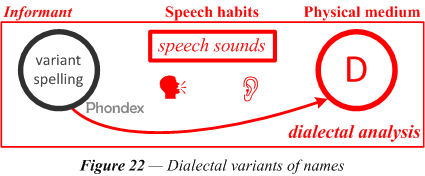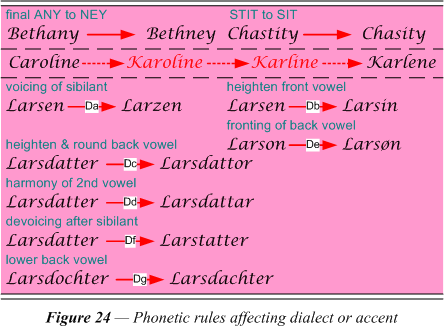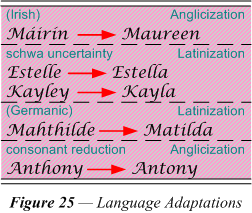
1.7 Dialect variation. The label “dialect variation” refers to the selection of vocabulary items that may change as we observe different speakers of a language. This variation is based on the variation in accent that arises from the phonemic or sound system of the language as it changes from generation to generation and varies from place to place. The clerk as a recorder of source documents creates a variant spelling by selecting those speech sounds due to temporal or spatial differences between his system and those of the informant, which may be relatively archaic, provincial, or even foreign. In many cases, and these are the only ones important in names processing, the phonemic structure is reflected directly in the spelling of the name. Dialectal phenomena are illustrated by “sparrow grass” for “asparagus” or “ashfelt” for “asphalt.” In general these variations also include what linguists call folk etymologies, malapropisms, mondegreens, Latinizations, Anglicizations, etc. These phenomena are beyond the multiple choice that allows a respelling of the same sound. Still, they are ultimately due to differences in accent. In short they result in multiple sounds for the same spelling.

One of the more drastic changes in the spelling of a name is illustrated in the examples in figure 23. In these cases the vowels of its two syllables are exchanged (metathesis). However, the first two examples do not reflect differences in accent and are not classified as “dialect” differences (D). These exemplify phonetic equivalences (P) in the choice made by the clerk due to uncertainty as to which letters ought to represent the sounds. In contrast, the last example is “dialect” (D), i.e., more likely due to either 1) the accent of the informant and/or 2) ignorance of the clerk. There is uncertainty about or ignorance of the conventional, local, or modern pronunciation of the name, .

In addition it is important to keep the dialect variations distinct, which are due to changes in accent or dialect, and which are neutralized using Phondex rules, from the variations which are caused by misreading the printed or written style of the letters, which are neutralized using Viewex rules (V). Dialect variants include cases where the actual number of syllables may change.

The examples in figure 24 illustrate some of the less primitive elements of change along the dimension of dialect, where the pronunciation changes. Sometimes these are more complex and chain together, in which cases assumed intervening elements may be unattested. Notice also in the case of “Karlene” that there may be intermediate steps required to analyze the change as a respelling that are unattested. The new pronunciation has motivated the new spelling, so that respelling has been posited in just two places. The remaining examples in the figure are from the dialect rules discovered in the study of Danish patronymic suffixes. Some of these seem to be influenced by or have their origin in other closely related languages.
Such processes as are found in the dialect dimension of analysis sometimes involve an impulse from a foreign language. In a sense they are borrowing or adaptations from that language. This motivates a different color scheme on figure 25 mixing a gray background with rose. There are a number of changes made to Irish names when English versions derive from them. These were called Anglicizations and some Anglicizations may be analyzed as dialect differences. Similarly there are a few of these kinds of changes found in English as influenced by Latin and called Latinizations. In some countries and cultures, such as Dutch in the Netherlands, the influence of Latin forms on given names and surnames is considerable.

The last example is one where pronunciation has been an influenced by the conventional spelling and vice versa leading to differences analyzed on the dialect dimension. When “th” is written in most European languages, it represents an aspirated “t” sound. However, in English there are many instances where it comes from the Anglo-Saxon thorn, pronounced now as an interdental fricative (voiced or voiceless). Confusion about whether the name was from one source or the other has led to respelling and multiple pronunciations.
